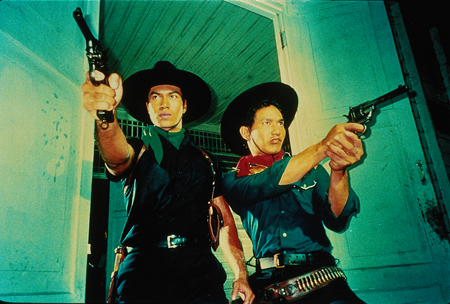|
Reviews of Recent Independent, Foreign, & Documentary Films in Theaters and DVD/Home Video
Written & Directed by: Wisit Sasanatieng. Produced by: Nonzee Nimibutr. Director of Photography by: Nattawut Kittikhun. Edited by: Dusanee Puinongpho. Music by: Amornbhong Methakunavudh. Released by: Magnolia Pictures. Language: Thai with English subtitles. With: Chartchai Ngamsan, Stella Malucchi, Supakorn Kitsuwon, Arawat Ruangvuth & Sombati Medhanee Tears of the Black Tiger, or Fah talai jone (which, according to Imdb.com trivia, is, in actuality, almost impossible to translate into English), needs a little plot exposition, even if in the grand scheme of things it doesn’t matter. It’s a romantic melodrama at its core involving a love that started in youth between Dum, a boy from the lower classes in Thailand, and Rumpoey, daughter of royalty. Though their romance is doomed by their class differences, he promises her that one day they will get married. But as revealed in flashbacks, Dum’s father is killed by bandits, causing Dum to seek immediate revenge by joining with another group of bandits and becoming the Black Tiger, a go-for-broke cowboy and the sharpest shooter there is. In the meantime, an arranged marriage is put into place between a police captain and Rumpoey, with the fiancé becoming a willing killer for his future father-in-the-law. Soon all of the cards fall into place, with Dum and Rumpoey’s fates soon colliding. If I didn’t do the greatest job in describing this, no bother. The plot resides in that perfunctory set-up of the old “boy finds girl, boy loses girl, boy finds girl again, girl doesn’t want to get married.” This is just fine for writer/director Wisit Sasanatieng, as he has a love for the mechanics of the storyline – a shabby, blood-stained clothesline for what he really wants to do with his picture. Going into the film, I had never seen anything from Thailand, let alone something as crazy as this. The style is described in the press notes as a tribute to the Thailand melodramas of the 1960s. But I see far more an influence of spaghetti westerns (for the heavy amount of gunfights, the quotient of violence, and even a snippet of Ennio Morricone’s music from For a Few Dollars More), as well as pulp novels, comic books, and the underground movies of the 1970s from across the world. The movie balances its romantic tendencies – it nearly becomes schmaltzy with the love triangle – and its hysterical action set pieces. The greatest thing that I could say about Tears is that it takes itself completely seriously in its unashamedly B-movie clothing and almost never falters in its technical skill. Filmed in dazzling colors, it’s so over-the-top it would likely give Tarantino an audio-visual orgasm.
I would’ve thought it was a relic from the by-gone era of grind house movie theaters if I had not read the notes. (Apparently, it was released
in 2000 in Thailand and sat on the Miramax shelves for six years before finally being dusted off by Magnolia Pictures.) Cult movie fans should
rejoice over something like this. This all being said, I recommend the movie against my better judgment, as it's close to being one of those
“so bad it’s great” movies that you watch with friends and goof on all the way through. If it were playing at midnight somewhere, and you know you’re already the kind of viewer who’ll go to this kind of movie, it’s the secret pleasure of the season and the best of its kind since Kung Fu Hustle.
Jack Gattanella
|

